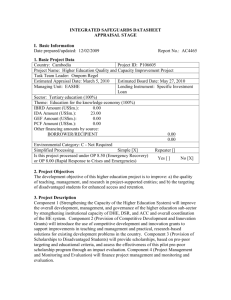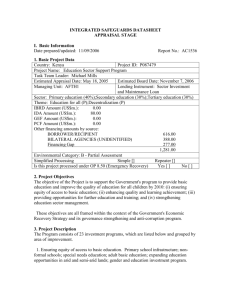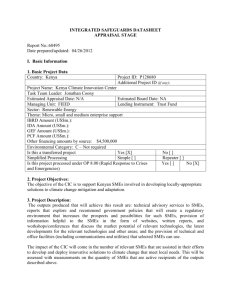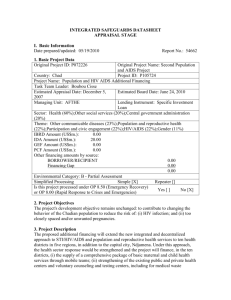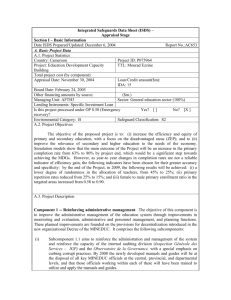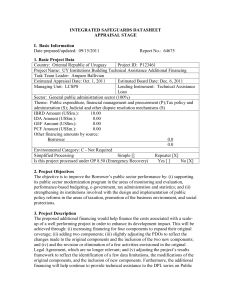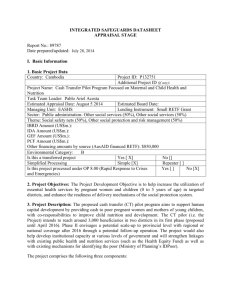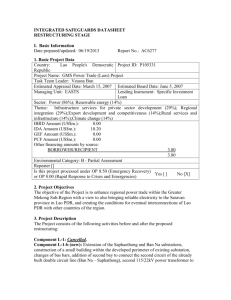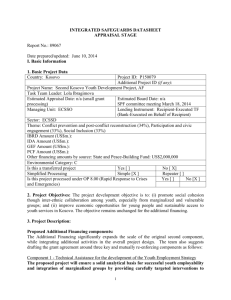INTEGRATED SAFEGUARDS DATA SHEET APPRAISAL STAGE
advertisement
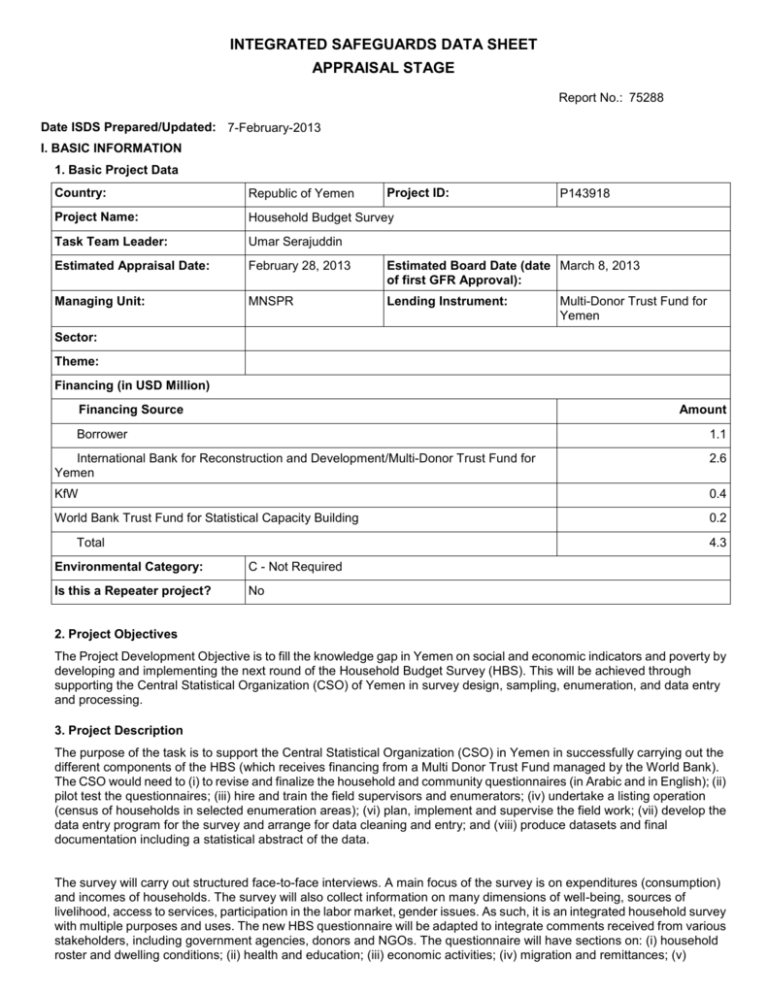
INTEGRATED SAFEGUARDS DATA SHEET APPRAISAL STAGE . Report No.: 75288 . Date ISDS Prepared/Updated: 7-February-2013 I. BASIC INFORMATION 1. Basic Project Data Country: Republic of Yemen Project ID: Project Name: Household Budget Survey Task Team Leader: Umar Serajuddin Estimated Appraisal Date: February 28, 2013 Estimated Board Date (date March 8, 2013 of first GFR Approval): Managing Unit: MNSPR Lending Instrument: P143918 Multi-Donor Trust Fund for Yemen Sector: Theme: Financing (in USD Million) Financing Source Amount Borrower 1.1 International Bank for Reconstruction and Development/Multi-Donor Trust Fund for Yemen 2.6 KfW 0.4 World Bank Trust Fund for Statistical Capacity Building 0.2 Total 4.3 Environmental Category: C - Not Required Is this a Repeater project? No . . 2. Project Objectives The Project Development Objective is to fill the knowledge gap in Yemen on social and economic indicators and poverty by developing and implementing the next round of the Household Budget Survey (HBS). This will be achieved through supporting the Central Statistical Organization (CSO) of Yemen in survey design, sampling, enumeration, and data entry and processing. . 3. Project Description The purpose of the task is to support the Central Statistical Organization (CSO) in Yemen in successfully carrying out the different components of the HBS (which receives financing from a Multi Donor Trust Fund managed by the World Bank). The CSO would need to (i) to revise and finalize the household and community questionnaires (in Arabic and in English); (ii) pilot test the questionnaires; (iii) hire and train the field supervisors and enumerators; (iv) undertake a listing operation (census of households in selected enumeration areas); (vi) plan, implement and supervise the field work; (vii) develop the data entry program for the survey and arrange for data cleaning and entry; and (viii) produce datasets and final documentation including a statistical abstract of the data. The survey will carry out structured face-to-face interviews. A main focus of the survey is on expenditures (consumption) and incomes of households. The survey will also collect information on many dimensions of well-being, sources of livelihood, access to services, participation in the labor market, gender issues. As such, it is an integrated household survey with multiple purposes and uses. The new HBS questionnaire will be adapted to integrate comments received from various stakeholders, including government agencies, donors and NGOs. The questionnaire will have sections on: (i) household roster and dwelling conditions; (ii) health and education; (iii) economic activities; (iv) migration and remittances; (v) consumption and expenditures; (vi) income; (vii) durable goods and loans; (viii) social assistance; (ix) gender; (x) subjective questions on wellbeing. A separate community questionnaire will collect community level information. Several key innovations on survey implementation have already been decided upon to improve survey quality and reliability, and to account for the prevailing security related uncertainties. - The CSO has agreed to integrate computer-based quality controls to field work. Data entry specialists will accompany survey enumerators in the field, enter the data daily, and apply consistency controls on a household–by-household basis so that errors and inconsistencies are solved by means of eventual re-visits to the households. The quality-assured databases will be transferred to survey headquarters bi-weekly (or more often). This will have a significant impact on the quality of data because errors and inconsistencies will be corrected while the interviewers are still in the field. The fast transfer of data also gives the survey managers the ability to effectively monitor field operations. - The CSO is optimistic of accessing all parts of Yemen as its survey enumerators are local. However, given the prevailing and unpredictable security situation in Yemen, the CSO will have to adopt a survey implementation approach which allows for temporary and localized disruptions. The CSO will coordinate closely with international survey and sampling experts who have experience in dealing with such replacements in fragile contexts. - The CSO will simplify the administration of the consumption module (by shortening the data collection period from four weeks to two weeks), which will make the survey easier to administer and is expected to improve the quality of consumption data, which is central to creating poverty statistics. 4. Project location and salient physical characteristics relevant to the safeguard analysis (if known) Not applicable . 5. Environmental and Social Safeguards Specialists on the Team - not applicable . 6.Safeguard Policies Triggerred? Explanation (Optional) Environmental Assessment OP/BP 4.01 No The proposed Project is rated Category C for environmental purposes. Natural Habitats OP/BP 4.04 No Forests OP/BP 4.36 No Pest Management OP 4.09 No Physical Cultural Resources OP/BP 4.11 No Indigenous Peoples OP/BP 4.10 No Involuntary Resettlement OP/BP 4.12 No The Project does not involve any physical structure or construction, there is no restriction or acquisition of land planned in the Project’s activities. No new buildings are to be constructed. Therefore, the project is rated C and will not trigger the OP 4.12 Safety of Dams OP/BP 4.37 No Projects on International Waterways OP/BP 7.50 No Projects in Disputed Areas OP/BP 7.60 . No II. Key Safeguard Policy Issues and Their Management A. Summary of Key Safeguard Issues 1. Describe any safeguard issues and impacts associated with the proposed project. Identify and describe any potential large scale, significant and/or irreversible impacts: The Project will assist the CSO to carry out surveys, including provision of technical assistance in survey design and implementation. As such, there are no safeguard issues associated with the Project. 2. Describe any potential indirect and/or long term impacts due to anticipated future activities in the project area: Not applicable 3. Describe any project alternatives (if relevant) considered to help avoid or minimize adverse impacts. Not applicable 4. Describe measures taken by the borrower to address safeguard policy issues. Provide an assessment of borrower capacity to plan and implement the measures described. Not applicable 5. Identify the key stakeholders and describe the mechanisms for consultation and disclosure on safeguard policies, with an emphasis on potentially affected people. . B. Disclosure Requirements Environmental Assessment/Audit/Management Plan/Other Was the document disclosed prior to appraisal? NA Date of receipt by the Bank NA Date of "in-country" disclosure NA Date of submission to InfoShop NA For category A projects, date of distributing the Executive Summary of the EA to the Executive Directors If the project triggers the Pest Management and/or Physical Cultural Resources policies, the respective issues are to be addressed and disclosed as part of the Environmental Assessment/Audit/or EMP. If in-country disclosure of any of the above documents is not expected, please explain why: The Project is Category C - Disclosure to Infoshop only. . C. Compliance Monitoring Indicators at the Corporate Level (to be filled in when the ISDS is finalized by the project decision meeting) OP/BP/GP 4.01 - Environment Assessment Does the project require a stand-alone EA (including EMP) report? Yes [ ] No [ X ] NA No [ ] NA [ ] The World Bank Policy on Disclosure of Information Have relevant safeguard policies documents been sent to the World Bank's Infoshop? Yes [X ] Have relevant documents been disclosed in-country in a public place in a form and language that are understandable and accessible to project-affected groups and local NGOs? Yes [ ] ] No [ ] NA [ X ] [ ] No [ ] NA [X ] All Safeguard Policies Have satisfactory calendar, budget and clear institutional responsibilities been prepared for the implementation of measures related to safeguard policies? Yes Have costs related to safeguard policy measures been included in the project cost? Yes [ ] No [ ] NA [X ] Does the Monitoring and Evaluation system of the project include the monitoring of safeguard impacts and measures related to safeguard policies? Yes [ ] No [ ] NA [ X ] Have satisfactory implementation arrangements been agreed with the borrower and the Yes [ ] No [ ] NA [ X ] same been adequately reflected in the project legal documents? . . III. APPROVALS . Task Team Leader: Name: Umar Serajuddin Approved By: Regional Safeguards Coordinator: Name: Not applicable – Project is Transferred to Date: Not applicable Task Team Sector Manager: Name: Bernard Funck Date: February 7, 2013
